ABOUT US
We are security engineers who break bits and tell stories.
Visit us
doyensec.com
Follow us
@doyensec
Engage us
info@doyensec.com
Blog Archive
© 2025 Doyensec LLC 
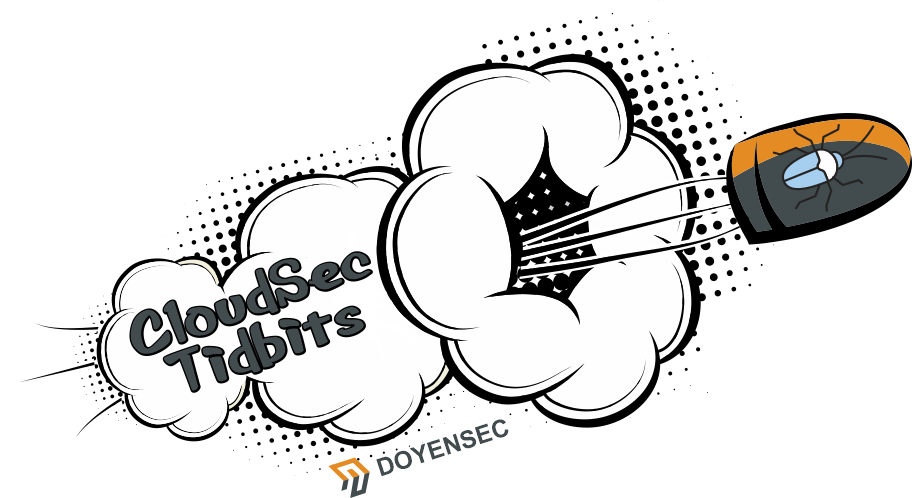
When it comes to Cloud Security, the first questions usually asked are:
As application security engineers, we think that there are more interesting and context-related questions such as:
By answering these questions, we usually find bugs.
Today we introduce the “CloudSecTidbits” series to share ideas and knowledge about such questions.
CloudSec Tidbits is a blogpost series showcasing interesting bugs found by Doyensec during cloud security testing activities. We’ll focus on times when the cloud infrastructure is properly configured, but the web application fails to use the services correctly.
Each blogpost will discuss a specific vulnerability resulting from an insecure combination of web and cloud related technologies. Every article will include an Infrastructure as Code (IaC) laboratory that can be easily deployed to experiment with the described vulnerability.
Amazon Web Services offers a comprehensive SDK to interact with their cloud services.
Let’s first examine how credentials are configured. The AWS SDKs require users to pass access / secret keys in order to authenticate requests to AWS. Credentials can be specified in different ways, depending on the different use cases.
When the AWS client is initialized without directly providing the credential’s source, the AWS SDK acts using a clearly defined logic. The AWS SDK uses a different credential provider chain depending on the base language. The credential provider chain is an ordered list of sources where the AWS SDK will attempt to fetch credentials from. The first provider in the chain that returns credentials without an error will be used.
For example, the SDK for the Go language will use the following chain:
The code snippet below shows how the SDK retrieves the first valid credential provider:
Source: aws-sdk-go/aws/credentials/chain_provider.go
// Retrieve returns the credentials value or error if no provider returned
// without error.
//
// If a provider is found it will be cached and any calls to IsExpired()
// will return the expired state of the cached provider.
func (c *ChainProvider) Retrieve() (Value, error) {
var errs []error
for _, p := range c.Providers {
creds, err := p.Retrieve()
if err == nil {
c.curr = p
return creds, nil
}
errs = append(errs, err)
}
c.curr = nil
var err error
err = ErrNoValidProvidersFoundInChain
if c.VerboseErrors {
err = awserr.NewBatchError("NoCredentialProviders", "no valid providers in chain", errs)
}
return Value{}, err
}
After that first look at AWS SDK credentials, we can jump straight to the tidbit case.
By testing several web platforms, we noticed that data import from external cloud services is an often recurring functionality. For example, some web platforms allow data import from third-party cloud storage services (e.g., AWS S3).
In this specific case, we will focus on a vulnerability identified in a web application that was using the AWS SDK for Go (v1) to implement an “Import Data From S3” functionality.
The user was able to make the platform fetch data from S3 by providing the following inputs:
S3 bucket name - Import from public source case;
OR
S3 bucket name + AWS Credentials - Import from private source case;
The code paths were handled by a function similar to the following structure:
func getObjectsList(session *Session, config *aws.Config, bucket_name string){
//initilize or re-initilize the S3 client
S3svc := s3.New(session, config)
objectsList, err := S3svc.ListObjectsV2(&s3.ListObjectsV2Input{
Bucket: bucket_name
})
return objectsList, err
}
func importData(req *http.Request) (success bool) {
srcConfig := &aws.Config{
Region: &config.Config.AWS.Region,
}
req.ParseForm()
bucket_name := req.Form.Get("bucket_name")
accessKey := req.Form.Get("access_key")
secretKey := req.Form.Get("secret_key")
region := req.Form.Get("region")
session_init, err := session.NewSession()
if err != nil {
return err, nil
}
aws_config = &aws.Config{
Region: region,
}
if len(accessKey) > 0 {
aws_config.Credentials = credentials.NewStaticCredentials(accessKey, secretKey, "")
} else {
aws_config.Credentials = credentials.AnonymousCredentials
}
objectList, err := getObjectsList(session_init, aws_config, bucket_name)
...
Despite using credentials.AnonymousCredentials when the user was not providing keys, the function had an interesting code path when ListObjectsV2 returned errors:
...
if err != nil {
if err, awsError := err.(awserr.Error); awsError {
aws_config.credentials = nil
getObjectsList(session_init, aws_config, bucket_name)
}
}
The error handling was setting aws_config.credentials = nil and trying again to list the objects in the bucket.
 Looking at
Looking at aws_config.credentials = nilUnder those circumstances, the credentials provider chain will be used and eventually the instance’s IAM role will be assumed. In our case, the automatically retrieved credentials had full access to internal S3 buckets.
If internal S3 bucket names are exposed to the end-user by the platform (e.g., via network traffic), the user can use them as input for the “import from S3” functionality and inspect their content directly in the UI.
 Reading internal bucket names list extracted from Burp Suite history
Reading internal bucket names list extracted from Burp Suite historyIn fact, it is not uncommon to see internal bucket names in an application’s traffic as they are often used for internal data processing. In conclusion, providing internal bucket names resulted in them being fetched from the import functionality and added to the platform user’s data.
AWS SDK clients require a Session object containing a Credential object for the initialization.
Described below are the three main ways to set the credentials needed by the client:
Within the credentials package, the NewStaticCredentials function returns a pointer to a new Credentials object wrapping static credentials.
Client initialization example with NewStaticCredentials:
package testing
import (
"time"
"github.com/aws/aws-sdk-go/aws"
"github.com/aws/aws-sdk-go/aws/credentials"
"github.com/aws/aws-sdk-go/aws/session"
)
var session = session.Must(session.NewSession(&aws.Config{
Credentials: credentials.NewStaticCredentials("AKIA….", "Secret", "Session"),
Region: aws.String("us-east-1"),
}))
Note: The credentials should not be hardcoded in code. Instead retrieve them from a secure vault at runtime.
If the session client is initialized without specifying a credential object, the credential provider chain will be used. Likewise, if the Credentials object is directly initialized to nil, the same behavior will occur.
Client initialization example without Credential object:
svc := s3.New(session.Must(session.NewSession(&aws.Config{
Region: aws.String("us-west-2"),
})))
Client initialization example with a nil valued Credential object:
svc := s3.New(session.Must(session.NewSession(&aws.Config{
Credentials: <nil_object>,
Region: aws.String("us-west-2"),
})))
Outcome: Both initialization methods will result in relying on the credential provider chain. Hence, the credentials (probably very privileged) retrieved from the chain will be used. As shown in the aforementioned “Import From S3” case study, not being aware of such behavior led to the exfiltration of internal buckets.
The right function for the right tasks ;)
AWS SDK for Go API Reference is here to help:
“AnonymousCredentials is an empty Credential object that can be used as dummy placeholder credentials for requests that do not need to be signed. This
AnonymousCredentialsobject can be used to configure a service not to sign requests when making service API calls. For example, when accessing public S3 buckets.”
svc := s3.New(session.Must(session.NewSession(&aws.Config{
Credentials: credentials.AnonymousCredentials,
})))
// Access public S3 buckets.
Basically, the AnonymousCredentials object is just an empty Credential object:
// source: https://github.com/aws/aws-sdk-go/blob/main/aws/credentials/credentials.go#L60
// AnonymousCredentials is an empty Credential object that can be used as
// dummy placeholder credentials for requests that do not need to be signed.
//
// These Credentials can be used to configure a service not to sign requests
// when making service API calls. For example, when accessing public
// s3 buckets.
//
// svc := s3.New(session.Must(session.NewSession(&aws.Config{
// Credentials: credentials.AnonymousCredentials,
// })))
// // Access public S3 buckets.
var AnonymousCredentials = NewStaticCredentials("", "", "")
The vulnerability could be also found in the usage of other AWS services.
While auditing cloud-driven web platforms, look for every code path involving an AWS SDK client initialization.
For every code path answer the following questions:
Is the code path directly reachable from an end-user input point (feature or exposed API)?
e.g., AWS credentials taken from the user settings page within the platform or a user submits an AWS public resource to have it fetched/modified by the platform.
How are the client’s credentials initialized?
aws.Config structure as input parameter - Look for the passed role’s permissionsCan users abuse the functionality to make the platform use the privileged credentials on their behalf and point to private resources within the AWS account?
e.g., “import from S3” functionality abused to import the infrastructure’s private buckets
Use the AnonymousAWSCredentials to configure the AWS SDK client when dealing with public resources.
From the official AWS documentations:
Using anonymous credentials will result in requests not being signed before sending them to the service. Any service that does not accept unsigned requests will return a service exception in this case.
In case of user provided credentials being used to integrate with other cloud services, the platform should avoid implementing fall-back to system role patterns. Ensure that the user provided credentials are correctly set to avoid ending up with aws.Config.Credentials = nil because it would result in the client using the credentials provider chain → System role.
As promised in the series’ introduction, we developed a Terraform (IaC) laboratory to deploy a vulnerable dummy application and play with the vulnerability: https://github.com/doyensec/cloudsec-tidbits/
Stay tuned for the next episode!
There are many security solutions available today that rely on the Extended Berkeley Packet Filter (eBPF) features of the Linux kernel to monitor kernel functions. Such a paradigm shift in the latest monitoring technologies is being driven by a variety of reasons. Some of them are motivated by performance needs in an increasingly cloud-dominated world, among others. The Linux kernel always had kernel tracing capabilities such as kprobes (2.6.9), ftrace (2.6.27 and later), perf (2.6.31), or uprobes (3.5), but with BPF it’s finally possible to run kernel-level programs on events and consequently modify the state of the system, without needing to write a kernel module. This has dramatic implications for any attacker looking to compromise a system and go undetected, opening new areas of research and application. Nowadays, eBFP-based programs are used for DDoS mitigations, intrusion detection, container security, and general observability.
In 2021 Teleport introduced a new feature called Enhanced Session Recording to close some monitoring gaps in Teleport’s audit abilities. All issues reported have been promptly fixed, mitigated or documented as described in their public Q4 2021 report. Below you can see an illustration of how we managed to bypass eBPF-based controls, along with some ideas on how red teams or malicious actors could evade these new intrusion detection mechanisms. These techniques can be generally applied to other targets while attempting to bypass any security monitoring solution based on eBPF:
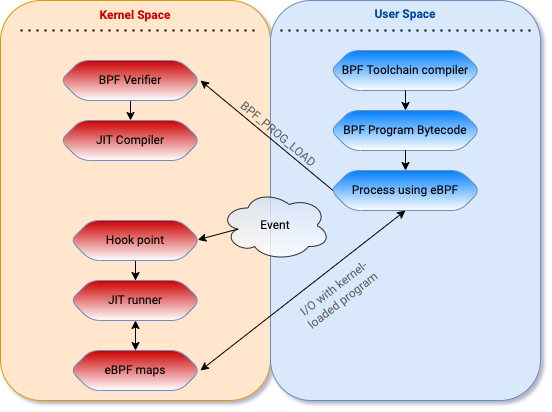
Extended BPF programs are written in a high-level language and compiled into eBPF bytecode using a toolchain. A user mode application loads the bytecode into the kernel using the bpf() syscall, where the eBPF verifier will perform a number of checks to ensure the program is “safe” to run in the kernel. This verification step is critical — eBPF exposes a path for unprivileged users to execute in ring 0. Since allowing unprivileged users to run code in the kernel is a ripe attack surface, several pieces of research in the past focused on local privilege exploitations (LPE), which we won’t cover in this blog post.
After the program is loaded, the user mode application attaches the program to a hook point that will trigger the execution when a certain hook point (event) is hit (occurs). The program can also be JIT compiled into native assembly instructions in some cases. User mode applications can interact with, and get data from, the eBPF program running in the kernel using eBPF maps and eBPF helper functions.
While eBPF is fast (much faster than auditd), there are plenty of interesting areas that can’t be reasonably instrumented with BPF due to performance reasons. Depending on what the security monitoring solution wants to protect the most (e.g., network communication vs executions vs filesystem operations), there could be areas where excessive probing could lead to a performance overhead pushing the development team to ignore them. This depends on how the endpoint agent is designed and implemented, so carefully auditing the code security of the eBPF program is paramount.
By way of example, a simple monitoring solution could decide to hook only the execve system call. Contrary to popular belief, multiple ELF-based Unix-like kernels don’t need a file on disk to load and run code, even if they usually require one. One way to achieve this is by using a technique called reflective loading. Reflective loading is an important post-exploitation technique usually used to avoid detection and execute more complex tools in locked-down environments. The man page for execve() states: “execve() executes the program pointed to by filename…”, and goes on to say that “the text, data, bss, and stack of the calling process are overwritten by that of the program loaded”. This overwriting doesn’t necessarily constitute something that the Linux kernel must have a monopoly over, unlike filesystem access, or any number of other things. Because of this, the execve() system call can be mimicked in userland with a minimal difficulty. Creating a new process image is therefore a simple matter of:
By following these six steps, a new process image can be created and run. Since this technique was initially reported in 2004, the process has nowadays been pioneered and streamlined by OTS post-exploitation tools. As anticipated, an eBPF program hooking execve would not be able to catch this, since this custom userland exec would effectively replace the existing process image within the current address space with a new one. In this, userland exec mimics the behavior of the system call execve(). However, because it operates in userland, the kernel process structures which describe the process image remain unchanged.
Other system calls may go unmonitored and decrease the detection capabilities of the monitoring solution. Some of these are clone, fork, vfork, creat, or execveat.
Another potential bypass may be present if the BPF program is naive and trusts the execve syscall argument referencing the complete path of the file that is being executed. An attacker could create symbolic links of Unix binaries in different locations and execute them - thus tampering with the logs.
Not hooking all the network-related syscalls can have its own set of problems. Some monitoring solutions may only want to hook the EGRESS traffic, while an attacker could still send data to a non-allowed host abusing other network-sensitive operations (see aa_ops at linux/security/apparmor/include/audit.h:78) related to INGRESS traffic:
OP_BIND, the bind() function shall assign a local socket address to a socket identified by descriptor socket that has no local socket address assigned.OP_LISTEN, the listen() function shall mark a connection-mode socket, specified by the socket argument, as accepting connections.OP_ACCEPT, the accept() function shall extract the first connection on the queue of pending connections, create a new socket with the same socket type protocol and address family as the specified socket, and allocate a new file descriptor for that socket.OP_RECVMSG, the recvmsg() function shall receive a message from a connection-mode or connectionless-mode socket.OP_SETSOCKOPT, the setsockopt() function shall set the option specified by the option_name argument, at the protocol level specified by the level argument, to the value pointed to by the option_value argument for the socket associated with the file descriptor specified by the socket argument. Interesting options for attackers are SO_BROADCAST, SO_REUSEADDR, SO_DONTROUTE.Generally, the network monitoring should look at all socket-based operations similarly to AppArmor.
In case the same local user has mixed monitored and unmonitored console sessions, it could be possible for an attacker in a monitored session to leverage open file descriptors and sockets to send data to restricted hosts. In 2020 some versions of Linux kernels had introduced a new system call to achieve this called pidfd_getfd. A small number of operating systems (like Ubuntu) implement the Yama kernel module that limit file descriptor access to only child-parent processes. A PoC code for using this function is available on Github (TheZ3ro/fdstealer).

If only active console sessions are monitored, eBPF programs may only live for the time span of the session. By delaying the execution of a command (through sleep, timeout, sar, vmstat, inotifywait, at, cron …) and quitting the session, it could be possible to completely evade the solution.
cgroupA security monitoring solution may only be interested in auditing a specific user or cgroup (such in the context of a remote console session). Taking Teleport as an example, it achieves this by correlating every event to a session with control groups (cgroupv2 in particular). Control grouping is a Linux kernel feature to limit access to resources to a group of processes. It is used in many containerization technologies (behind the scenes Docker creates a set of namespaces and control groups for the container) and its peculiarity is that all child processes will keep the id of the parent process. When Teleport starts an SSH session, it first re-launches itself and places itself within a cgroup. This allows not only that process, but all future processes that Teleport launches, to be tracked with a unique ID. The BPF programs that Teleport runs have been updated to also emit the cgroup ID of the program executing them. The BPF script checks the value returned by bpf_get_current_cgroup_id() and only cares about the important session cgroup. The simplest evasion to this auditing strategy would be changing your cgroup ID, but an attacker needs to be root to achieve this. Meddling with the cgroupv2 pseudo file system or abusing PAM configuration are also potential opportunities to affect the cgroup/session correlation.
Another technique involves being reallocated by init. In the case of Teleport, when the bash process spawned by the session dies, its child processes become orphans and the Teleport process terminates its execution. When a child process becomes an orphan, it can be assigned to a different cgroup by the operating system under certain conditions (not having a tty, being a process group leader, joining a new process session). This allows an attacker to bypass the restrictions in place. The following PoC is an example of a bypass for this design:
tmux commandtmux by pressing CTRL+B and then Dtmux’s parenttmux process by executing tmux attach. The process tree will now look like this:
As another attack avenue, leveraging processes run by different local users/cgroupv2 on the machine (abusing other daemons, delegating systemd) can also help an attacker evade this. This aspect obviously depends on the system hosting the monitoring solution. Protecting against this is tricky, since even if PR_SET_CHILD_SUBREAPER is set to ensure that the descendants can’t re-parent themselves to init, if the ancestor reaper dies or is killed (DoS), then processes in that service can escape their cgroup “container”. Any compromise of this privileged service process (or malfeasance by it) allows it to kill its hierarchy manager process and escape all control.
BPF programs have a lot of constraints. Only 512 bytes of stack space are reserved for the eBPF program. Variables will get hoisted and instantiated at the start of execution, and if the script tries to dump syscall arguments or pt-regs, it will run out of stack space very quickly. If no workaround on the instruction limit is set, it could be possible to push the script into retrieving something too big to ever fit on the stack, losing visibility very soon when the execution gets complicated. But even when workarounds are used (e.g., when using multiple probes to trace the same events but capture different data, or split your code into multiple programs that call each other using a program map) there still may be a chance to abuse it. BPF programs are not meant to be run forever, but they have to stop at some point. By way of example, if a monitoring solution is running on CentOS 7 and trying to capture a process arguments and its environment variables, the emitted event could have too many argv and too many envp. Even in that case, you may miss some of them because the loop stops earlier. In these cases, the event data will be truncated. It’s important to note that these limitations are different based on the kernel where BPF is being run, and how the endpoint agent is written.
Another peculiarity of eBPFs is that they’ll drop events if they can not be consumed fast enough, instead of dragging down the performance of the entire system with it. An attacker could abuse this by generating a sufficient number of events to fill up the perf ringbuffer and overwrite data before the agent can read it.
The kernel-space understanding of a pid is not the same as the user-space understanding of a pid. If the eBPF script is trying to identify a file, the right way would be to get the inode number and device number, while a file descriptor won’t be as useful. Even in that case, probes could be subject to TOCTOU issues since they’ll be sending data to user mode that can easily change. If the script is instead tracing syscalls directly (using tracepoint or kprobe) it is probably stuck with file descriptors and it could be possible to obfuscate executions by playing around with the current working directory and file descriptors, (e.g., by combining fchdir, openat, and execveat).
seccomp-bpf & kernel discrepancieseBPF-based monitoring solutions should protect themselves by using seccomp-BPF to permanently drop the ability to make the bpf() syscall before spawning a console session. If not, an attacker will have the ability to make the bpf() syscall to unload the eBPF programs used to track execution. Seccomp-BPF uses BPF programs to filter arbitrary system calls and their arguments (constants only, no pointer dereference).
Another thing to keep in mind when working with kernels, is that interfaces aren’t guaranteed to be consistent and stable. An attacker may abuse eBPF programs if they are not run on verified kernel versions. Usually, conditional compilation for a different architecture is very convoluted for these programs and you may find that the variant for your specific kernel is not targeted correctly. One common pitfall of using seccomp-BPF is filtering on system call numbers without checking the seccomp_data->arch BPF program argument. This is because on any architecture that supports multiple system call invocation conventions, the system call numbers may vary based on the specific invocation. If the numbers in the different calling conventions overlap, then checks in the filters may be abused. It is therefore important to ensure that the differences in bpf() invocations for each newly supported architecture are taken into account by the seccomp-BPF filter rules.
Similarly to (6), it may be possible to interfere with the eBPF program loading in different ways, such as targeting the eBPF compiler libraries (BCC’s libbcc.so) or adapting other shared libraries preloading methods to tamper with the behavior of legit binaries of the solution, ultimately performing harmful actions. In case an attacker succeeds in altering the solution’s host environment, they can add in front of the LD_LIBRARY_PATH, a directory where they saved a malicious library having the same libbcc.so name and exporting all the symbols used (to avoid a runtime linkage error). When the solution starts, instead of the legit bcc library, it gets linked with the malicious library. Defenses against this may include using statically linked programs, linking the library with the full path, or running the program into a controlled environment.
Many thanks to the whole Teleport Security Team, @FridayOrtiz, @Th3Zer0, & @alessandrogario for the inspiration and feedback while writing this blog post.
Recently, a client of ours asked us to put R2c’s Semgrep in a head-to-head test with GitHub’s CodeQL. Semgrep is open source and free (with premium options). CodeQL “is free for research and open source” projects and accepts open source contributions to its libraries and queries, but is not free for most companies. Many of our engineers had already been using Semgrep frequently, so we were reasonably familiar with it. On the other hand, CodeQL hadn’t gained much traction for our internal purposes given the strict licensing around consulting. That said, our client’s use case is not the same as ours, so what works for us, may not work well for them. We have decided to share our results here.
A SAST tool generally consists of a few components 1) a lexer/parser to make sense of the language, 2) rules which process the output produced by the lexer/parser to find vulnerabilities and 3) tools to manage the output from the rules (tracking/ticketing, vulnerability classification, explanation text, prioritization, scheduling, third-party integrations, etc).
The rules are usually the source of most SAST complaints because ultimately, we all hope ideally that the tool produces perfect results, but that’s unrealistic. On one hand, you might get a tool that doesn’t find the bug you know is in the code (a false negative - FN) or on the other, it might return a bunch of useless supposed findings that are either lacking any real impact or potentially just plain wrong (a false positive - FP). This leads to our first issue when attempting to quantitatively measure how good a SAST tool is - what defines true/false or positives/negatives?
Some engineers might say a true positive is a demonstrably exploitable condition, while others would say matching the vulnerable pattern is all that matters, regardless of the broader context. Things are even more complicated for applications that incorporate vulnerable code patterns by design. For example, systems administration applications which executes shell commands, via parameters passed in a web request. In most environments, this is the worst possible scenario. However, for these types of apps, it’s their primary purpose. In those cases, engineers are then left with the subjective question of whether to classify a finding as a true or false positive where an application’s users can execute arbitrary code in an application, that they’d need to be fully and properly authenticated and authorized to do.
These types of issues come from asking too much of the SAST application and we should focus on locating vulnerable code patterns - leaving it to people to vet and sort the findings. This is one of the places where the third set of components comes into play and can be a real differentiator between SAST applications. How users can ignore the same finding class(es), findings on the same code, findings on certain paths, or conditionally ignoring things, becomes very important to filter the signal from the noise. Typically, these tools become more useful for organizations that are willing to commit the time to configure the scans properly and refine the results, rather than spending it triaging a bunch of issues they didn’t want to see in the first place and becoming frustrated.
Furthermore, quantitative comparisons between tools can be problematic for several reasons. For example, if tool A finds numerous low severity bugs, but misses a high severity one, while tool B finds only a high severity bug, but misses all the low severity ones, which is a better tool? Numerically, tool A would score better, but most organizations would rather find the higher severity vulnerability. If tool A finds one high severity vulnerability and B finds a different one, but not the one A finds, what does it mean? Some of these questions can be handled with statistical methods, but most people don’t usually take this approach. Additionally, issues can come up when you’re in a multi-language environment where a tool works great on one language and not so great on the others. Yet another twist might be if a tool missed a vulnerability that was due to a parsing error, that would certainly be fixed in a later release, rather than a rules matching issue specifically.
These types of concerns don’t necessarily have easy answers and it’s important to remember that any evaluation of a SAST tool is subject to variations based on the language(s) being examined, which rules are configured to run, the code repository’s structure and contents, and any customizations applied to the rules or tool configuration.
Another hurdle in properly evaluating a SAST tool is finding a body of code on which to test it. If the objective is to simply scan the code and verify whether the findings are true positives (TP) or false positives (FP), virtually any supported code could work, but finding true negatives (TN) and false negatives (FN) require prior knowledge of the security state of the code or having the code manually reviewed.
This then raises the question of how to quantify the negatives that a SAST tool can realistically discover. Broadly, a true positive is either a connection of a source and unprotected sink or possibly a stand-alone configuration (e.g., disabling a security feature). So how do we count true negatives specifically? Do we count the total number or sources that lead to a protected sink, the total of protected sinks, the total safe function calls (regardless if they are identified sinks), and all the safe configuration options? Of course, if the objective is solely to verify the relative quality of detection between competing software, simply comparing the results, provided all things were reasonably equal, can be sufficient.
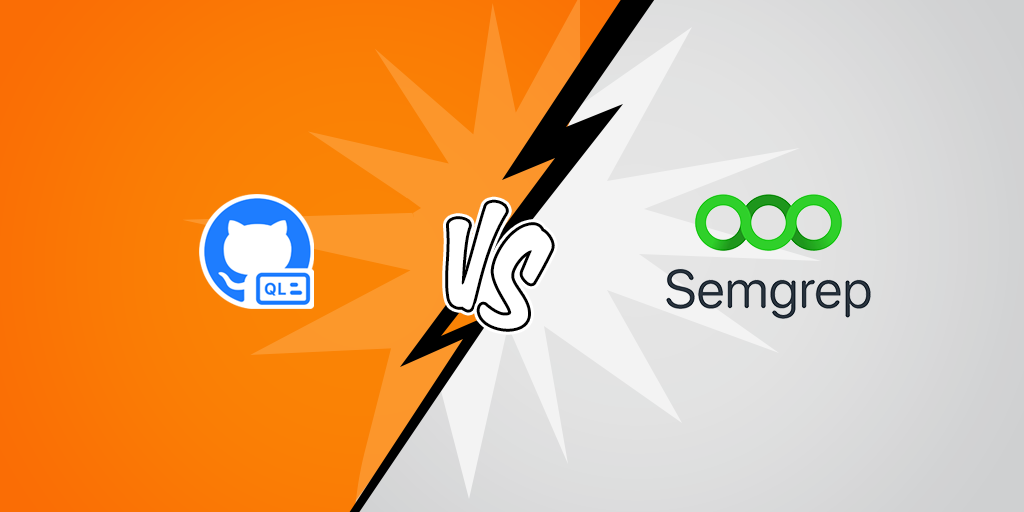
We utilized the OWASP Benchmark Project to analyze pre-classified Java application code to provide a more accurate head-to-head comparison of Semgrep vs. CodeQL. While we encountered a few bugs running the tools, we were able to work around them and produce a working test and meaningful results.
Both CodeQL and Semgrep came with sample code used to demonstrate the tool’s capabilities. We used the test suite of sample vulnerabilities from each tool to test the other, swapping the tested files “cross-tool”. This was done with the assumption that the test suite for each tool should return 100% accurate results for the original tool, by design, but not necessarily for the other. Some modifications and omissions were necessary however, due to the organization and structure of the test files.
We also ran the tools against a version of our client’s code in the manner that required the least amount of configuration and/or knowledge of the tools. This was intended to show what you get “out of the box” for each tool. We iterated over several configurations of the tools and their rules, until we came to a meaningful, yet manageable set of results (due to time constraints).
When comparing SAST tools, based on past experience, we feel these criteria are important aspects that need to be examined.
The images below outline the supported languages for each tool, refer to the source links for additional information about the supported frameworks:
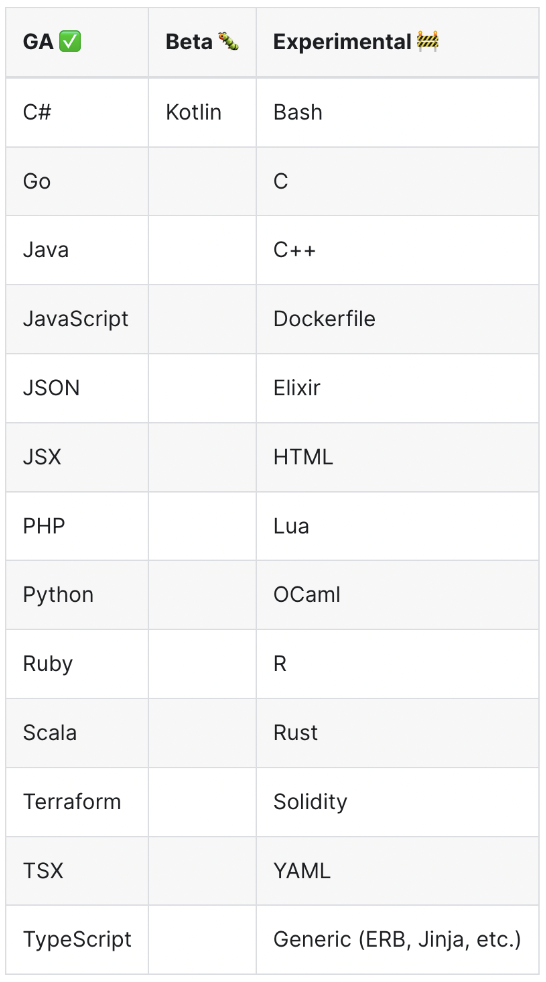
Source: https://semgrep.dev/docs/supported-languages/
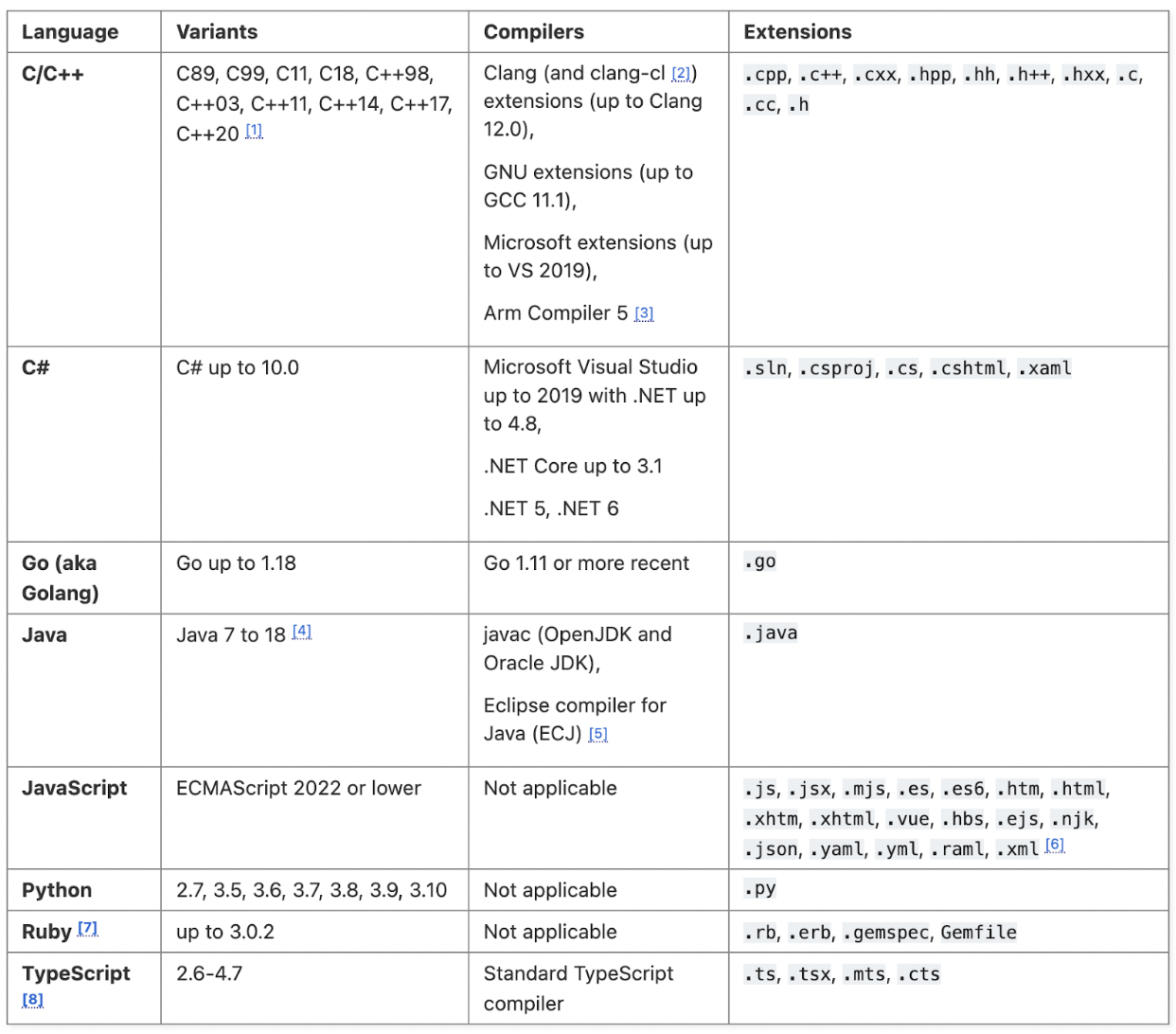
Source: https://codeql.github.com/docs/codeql-overview/supported-languages-and-frameworks/
Not surprisingly, we see support for many of the most popular languages in both tools, but a larger number, both in GA and under development in Semgrep. Generally speaking, this gives an edge to Semgrep, but practically speaking, most organizations only care if it supports the language(s) they need to scan.
Lexer/parser performance will vary based on the language and framework, their versions and code complexity. It is only possible to get a general sense of this by scanning numerous repositories and monitoring for errors or examining the source of the parser and tool.
During testing on various applications, both tools encountered errors allowing only the partial parsing of many files. The thoroughness of the parsing results varied depending on the tool and on the code being analyzed. Testing our client’s Golang project, we did occasionally encounter parsing errors with both as well.
We encountered an issue when testing against third-party code where a custom function (exit()) was declared and used, despite being reserved, causing the parser to fail once the function was reached, due to invalid syntax. The two notable things here are that the code should theoretically not work properly and that despite this, Semgrep was still able to perform a partial examination. Semgrep excelled in terms of the ability to handle incomplete code or code with errors as it operates on a single file scope generally.
CodeQL works a bit differently, in that it effectively creates a database from the code, allowing you to then write queries against that database to locate vulnerabilities. In order for it to do this, it requires a fully buildable application. This inherently means that it must be more strict with its ability to parse all the code.
In our testing, CodeQL generated errors on the majority of files that it had findings for (partial parsing at best), and almost none were analyzed without errors. Roughly 85% of files generated some errors during database creation.
According to CodeQL, a small number of extraction errors is normal, but a large number is not. It was unclear how to reduce the large number of extraction errors. According to CodeQL’s documentation, the only ways were to wait for CodeQL to release a fixed version of the extractor or to debug using the logs. We attempted to debug with the logs, but the error messages were not completely clear and it seemed that the two most common errors were related to the package names declared at the top of the files and variables being re-declared. It was not completely clear if these errors were due to an overly strict extractor or if the code being tested was incomplete.
Semgrep would seem to have the advantage here, but it’s not a completely fair comparison, due to the different modes of operation.
Among the options you can select when firing up a Semgrep scan are:
Notes:
While the tool does provide an automated scanning option, we found situations in which -–config auto did not find all the vulnerabilities that manually selecting the language did.
The re-use/tracking of the scan results requires using Semgrep CI or Semgrep App.
CodeQL requires a buildable application (i.e., no processing of a limited set of files), with a completely different concept of “scanning”, so this notion doesn’t directly translate. In effect, you create a database from the code, which you subsequently query to find bugs, so much of the “filtering” can be accomplished by modifying the queries that are run.
Options include:
Because CodeQL creates a searchable database, you can indefinitely run queries against the scanned version of the code.
Because of the different approaches it is difficult to say one tool has an advantage over the other. The most significant difference is probably that Semgrep allows you to automatically fix vulnerabilities.
As mentioned previously, these tools take completely different approaches (i.e., rules vs queries). Whether someone prefers writing queries vs. YAML is subjective, so we’ll not discuss the formats themselves specifically.
As primarily a string-matching static code analysis tool, Semgrep’s accuracy is mostly driven by the rules in use and their modes of operation. Semgrep is probably best thought of as an improvement on the Linux command line tool grep. It adds improved ease of use, multi-line support, metavariables and taint tracking, as well as other features that grep directly does not support. Beta features also include the ability to track across related files.
Semgrep rules are defined in relatively simple YAML files with only a handful of elements used to create them. This allows someone to become reasonably proficient with the tool in a matter of hours, after reading the documentation and tutorials. At times, the tool’s less than full comprehension of the code can cause rule writing to be more difficult than it might appear at first glance.
In Semgrep, there are several ways to execute rules, either locally or remotely. Additionally, you can pass them as command line arguments referred to as “ephemeral” rules, eliminating the YAML files altogether.
The rule below shows an example of a reasonably straightforward rule. It effectively looks for an insecure comparison of something that might be a secret within an HTTP request.
rules:
- id: insecure-comparison-taint
message: >-
User input appears to be compared in an insecure manner that allows for side-channel timing attacks.
severity: ERROR
languages: [go]
metadata:
category: security
mode: taint
pattern-sources:
- pattern-either:
- pattern: "($ANY : *http.Request)"
- pattern: "($ANY : http.Request)"
pattern-sinks:
- patterns:
- pattern-either:
- pattern: "... == $SECRET"
- pattern: "... != $SECRET"
- pattern: "$SECRET == ..."
- pattern: "$SECRET != ..."
- pattern-not: len(...) == $NUM
#- pattern-not: <... len(...) ...>
- metavariable-regex:
metavariable: $SECRET
regex: .*(secret|password|token|otp|key|signature|nonce).*
The logic in the rules is familiar and amounts to what feels like stacking of RegExs, but with the added capability of creating boundaries around what is matched against and with the benefit of language comprehension. It is important to note however that Semgrep lacks a full understanding of the code flow sufficient enough to trace source to sink flows through complex code. By default it works on a single file basis, but Beta features also include the ability to track across related files. Semgrep’s current capabilities lie somewhere between basic grep and a traditional static code analysis tool, with abstract syntax trees and control flow graphs.
No special preparation of repositories is needed before scanning can begin. The tool is fully capable of detecting languages and running simultaneous scans of multiple languages in heterogeneous code repositories. Furthermore, the tool is capable of running on code which isn’t buildable, but the tool will return errors when it parses what it deems as invalid syntax.
That said, rules tend to be more general than the queries in CodeQL and could potentially lead to more false positives. For some situations, it is not possible to make a rule that is completely accurate without customizing the rule to match a specific code base.
CodeQL’s query language has a SQL-like syntax with the following features:
The engine has extractors for each supported language. They are used to extract the information from the codebase into the database. Multi-language code bases are analyzed one at a time. Trying to specify a list of target languages (go, javascript and c) didn’t work out of the box because CodeQL required to explicitly set the build command for this combination of languages.
CodeQL can also be used in VSCode as an extension, a CLI tool or integrated with Github workflows. The VS extension code allows writing the queries with the support of the autocompletion by the IDE and testing them against one or more databases previously created.
The query below shows how you would search for the same vulnerability as the Semgrep rule above.
/**
* @name Insecure time comparison for sensitive information
* @description Input appears to be compared in an insecure manner (timing attacks)
*/
import go
from EqualityTestExpr e, DataFlow::CallNode called
where
// all the functions call where the argument matches the RegEx
called
.getAnArgument()
.toString()
.toLowerCase()
.regexpMatch(".*(secret|password|token|otp|key|signature|nonce).*") and
e.getAnOperand() = called.getExpr()
select called.getExpr(), "Uses a constant time comparison for sensitive information"
In order to create a database, CodeQL requires a buildable codebase. This means that an analysis consists of multiple steps: standard building of the codebase, creating the database and querying the codebase. Due to the complexity of the process in every step, our experience was that a full analysis can require a non-negligible amount of time in some cases.
Writing queries for CodeQL also requires a great amount of effort, especially at the beginning. The user should know the CodeQL syntax very well and pay attention to the structure of the condition to avoid killing the performance. We experienced an infinite compilation time just adding an OR condition in the WHERE clause of a query. Starting from zero experience with the tool, the benefits of using CodeQL are perceivable only in the long run.
As Semgrep allows you to output to a number of formats, along with the CLI output, there are a number of ways you can manage the findings. They also list some of this information on their manage-findings page.
Because the CodeQL CLI tool reports findings in a CSV or SARIF file format, triaging findings reported by it can be quite tedious. During testing, we felt the easiest way to review findings from the CodeQL CLI tool was to launch the query from Visual Studio Code and manually review the results from there (due to the IDE’s navigation features). Ultimately, in real-world usage, the results are probably best consumed through the integration with GitHub.
Due to the differences between their approaches, it’s difficult to fairly quantify the differences in speed between the two tools. Semgrep is a clear winner in the time it takes to setup, run a scan and get results. It doesn’t interpret the code as deeply as CodeQL does, nor does it have to create a persistent searchable database, then run queries against it. However, once the database is created, you could argue that querying for a specific bug in CodeQL versus scanning a project again in Semgrep would be roughly similar, depending on multiple factors not directly related to the tools (e.g., hardware, language, code complexity).
This highlights the fact that tool selection criteria should incorporate the use-case.
This section shows the results of using both of these SAST tools to test the same repository of Java code (the only language option). This project’s sample code had been previously reviewed and categorized, specifically to allow for benchmarking of SAST tools. Using this approach we could relatively easily run a head-to-head comparison and allow the OWASP Benchmark Project to score and graph the performance of each tool.
Drawbacks to this approach include the fact that it is one language, Java, and that is not the language of choice for our client. Additionally, SAST tool maintainers, who might be aware of this project, could theoretically ensure their tools perform well in these tests specifically, potentially masking shortcomings when used in broader contexts.
In this test, Semgrep was configured to run with the latest “security-audit” Registry ruleset, per the OWASP Benchmark Project recommendations. CodeQL was run using the “Security-and-quality queries” query suite. The CodeQL query suite includes queries from “security-extended”, plus maintainability and reliability queries.
As you can see from the charts below, Semgrep performed better, on average, than CodeQL did. Examining the rules a bit more closely, we see three CWE (Common Weakness Enumeration) areas where CodeQL does not appear to find any issues, significantly impacting the average performance. It should also be noted that CodeQL does outperform in some categories, but determining the per-category importance is left to the tool’s users.
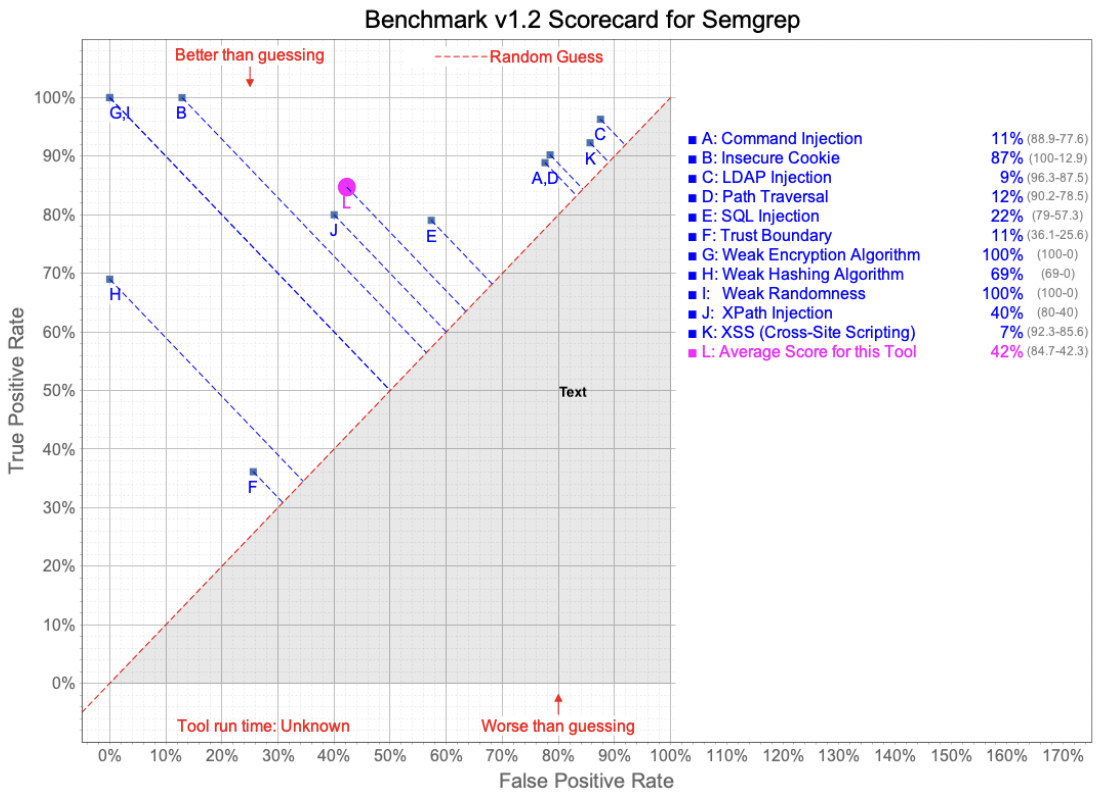
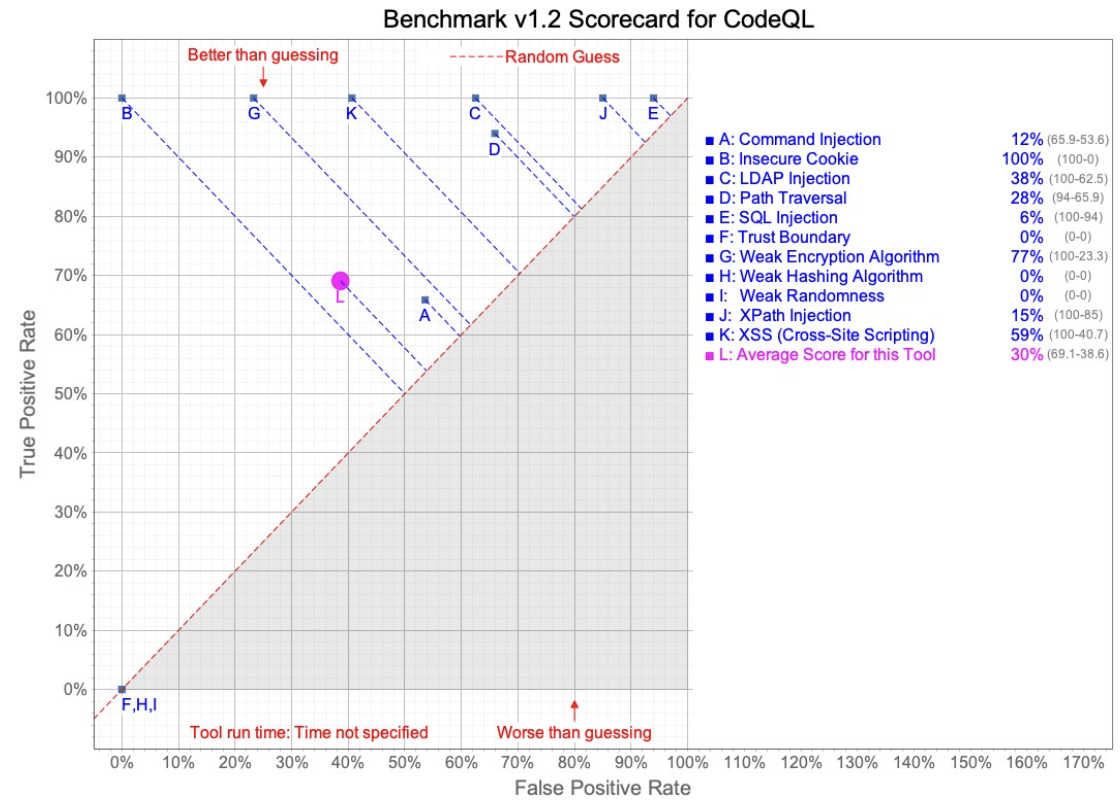
This section discusses the results of using the Semgrep tool against the test cases for CodeQL and vice versa. While initially seeming like a great way to compare the tools, unfortunately, the test case files presented several challenges to this approach. While being labeled things like “Good” and “Bad” either in file names or comments, the files were not necessarily all “Good” code or “Bad” code, but inconsistently mixed, inconsistently labeled and sometimes with multiple potential vulnerabilities in the same files. Additionally, we occasionally discovered vulnerabilities in some of the files which were not the CWE classes that were supposed to be in the files (e.g., finding XSS in an SQL Injection test case).
These issues prevented a simple count based on the files that were/were not found to have vulnerabilities. The statistics we present have been modified as much as possible in the allotted time to account for these issues and we have applied data analysis techniques to account for some of the errors.
As you can see in the table below, CodeQL performed significantly better with regards to detection, but at the cost of a higher false positive rate as well. This underscores some of the potential tradeoffs, mentioned in the introduction, which need to be considered by the consumer of the output.

Notes:
Semgrep’s configuration was limited to only running rules classified as security-related and only against Golang files, for efficiency’s sake.
Semgrep successfully identified vulnerabilities associated with CWE-327, CWE-322 and CWE-319
Semgrep’s results only included two vulnerabilities which were the one intended to be found in the file (e.g., test for X find X). The remainder were HTTPs issues (CWE-319) related to servers configured for testing purposes in the CodeQL rules (e.g., test for X but find valid Y instead).
CodeQL rules for SQL injection did not perform well in this case (~20% detection), but did better in cross-site scripting and other tests. There were fewer overall rules available during testing, compared to Semgrep, and vulnerability classes like Server Side Template Injection (SSTI) were not checked for, due to the absence of rules.
Out of 14 files that CodeQL generated findings for, only 2 were analyzed without errors. 85% of files generated some errors during database creation.
False negative rates can increase dramatically if CodeQL fails to extract data from code. It is essential to make sure that there are not excessive extraction errors when creating a database or running any of the commands that implicitly run the extractors.
This section discusses the results of using the tools to examine an open source Golang project for one of our clients.
In these tests, due to the aforementioned lack of a priori knowledge of the code’s true security status, we are forced to assume that all files without true positives are free from vulnerabilities and are therefore considered TNs and likewise that there are no FNs. This underscores that testing against code that has already been organized for evaluation can be assumed as more accurate.
Running Semgrep with the “r2c-security-audit” configuration, resulted in 15 Golang findings, all of which were true positives. That said, the majority of the findings were related to the use of the unsafe library. Due to the nature of this issue, we opted to only count it as one finding per file, as to not further skew the results, by counting each usage within a file.
As shown in the table below, both tools performed very well! CodeQL detected significantly more findings, but it should be noted that they were largely the same couple of issues across numerous files. In other words, there were repeated code patterns in many cases, skewing the volume of findings.

For the purposes of this exercise, TN = Total .go files - TP (890-15) = 875, since we are assuming all those files are free of vulnerabilities. For the Semgrep case, the value is irrelevant for the rate calculations, since no false positives were found.
Semgrep in --config auto mode resulted in thousands of findings when run against our client’s code, as opposed to tens of findings when limiting the scans to security-specific tests on Golang only. We cite this, to underscore that results will vary greatly depending on the code tested and rules applied. That reduction in scope resulted in no false positives during manually reviewed results.
For CodeQL, approximately 25% of the files were not scanned, due to issues with the tool
CodeQL encountered many errors during file compilation. 63 out of 74 Go files generated errors while being extracted to CodeQL’s database. This means that the analysis was performed on less data, and most files were only partially analyzed by CodeQL. This caused the CodeQL scan to result in significantly less findings than expected.
Obviously there could be some bias, but if you’d like another opinion, the creators of Semgrep have also provided a comparison with CodeQL on their website, particularly in this section : “How is Semgrep different from CodeQL?”.
Not surprisingly, in the end, we still feel Semgrep is a better tool for our use as a security consultancy boutique doing high-quality manual audits. This is because we don’t always have access to all the source code that we’d need to use CodeQL, the process of setting up scans is more laborious and time consuming in CodeQL. Additionally, we can manually vet findings ourselves - so a few extra findings isn’t a major issue for us and we can use it for free. If an organization’s use-case is more aligned with our client’s - being an organization that is willing to invest the time and effort, is particularly sensitive to false positives (e.g. running a scan during CI/CD) and doesn’t mind paying for the licensing, CodeQL might be a better choice for them.